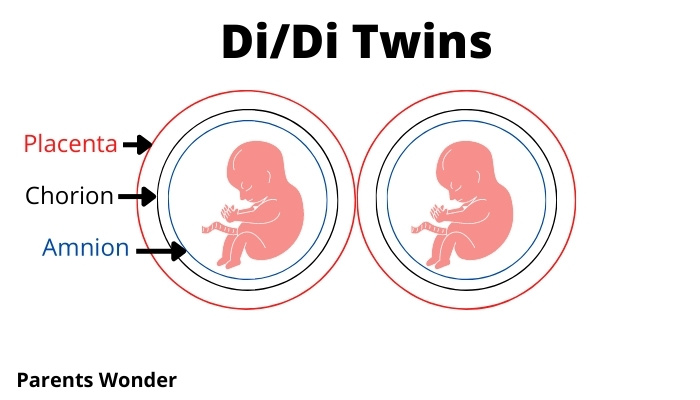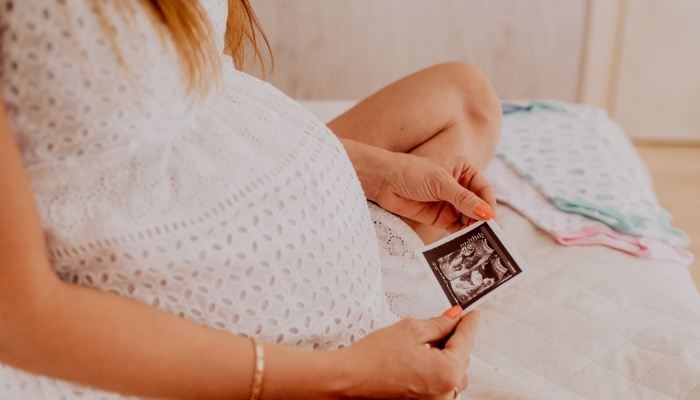There are various forms of twin pregnancies, and understanding how your infants develop in the uterus can indicate the type of twin pregnancy you are having.
Ultrasounds are one way that doctors figure out what kind of twin pregnancy you’re going through.
What are di/di twins? Di/di twins are twins that have their own chorionic and amniotic sacs. Di/di pregnancies can still be high risk but tend to be safer than other types because each baby grows in its own space, even though it’s happening at the same time. Di/di twins can be monozygotic or dizygotic, though the majority are dizygotic.
So what do chorionic and amniotic sacs have to do with what type of twin pregnancy you’re experiencing and what risks you’ll face? There’s a lot to know, so here’s a solid overview.
Dichorionic Diamniotic Twins
Dichorionic diamniotic twins basically grow like any baby in the womb, though they are in there at the same time. They have borders to their space.
How Twins Develop – The Basics
Twins develop either by hyperovulation or by a fertilized egg splitting. Hyperovulation means more than one egg is released, and this results in fraternal twins.
A fertilized egg splitting creates identical twins. Both identical and fraternal twins can be di/di.
Understanding Di/Di Twins
Di/di twins form in one of two ways: they are conceived when two eggs are released and fertilized by different sperm or when one fertilized egg splits very early.
These two separate embryos become surrounded by their own chorionic sac, the outermost fetal membrane that will help keep them protected throughout the pregnancy.
Di/di twins also have their own amniotic sacs. This means they each have their own bag of water to protect them until birth.

Di/Di Twins Sex
Di/di twins can be the same or different sexes. If di/di twins are identical, then they will be the same sex, but fraternal di/di twins make up the majority and can be either a girl or a boy.
Are All Di/Di Twins Fraternal?
Not all di/di twins are fraternal. Each baby having its own chorion and amniotic sac doesn’t mean they came from two different eggs.
In a small number of cases, a fertilized egg will split very early, usually within the first three days, and each baby will have its own chorionic and amniotic sac. However, these babies will be identical twins.
Most of the time di/di twins are fraternal, but not always.
What Percentage of Identical Twins Are Di/Di?
Only about 30 percent of identical twins are di/di according to current estimates.
How Do You Know if Your Twins Are Di/Di?
Many doctors can determine if your twins are di/di through an ultrasound. They will be able to see two chorionic sacs and the membrane that spits the amniotic sacs, one for each baby. so each baby has its own.
Di/Di Twin Pregnancy Risks
The good news is di/di twin pregnancies are the lowest risk pregnancies when you’re carrying multiples. However, you are still at increased risk of complications simply because you’re housing and growing two babies.
These risks include:
- Premature birth
- Placenta issues, such as placenta previa or placental abruption
- Gestational diabetes
Dichorionic Diamniotic Twins Delivery
Di/di twins can be delivered vaginally if baby A is head down. Because each baby has its own chorionic and amniotic sac, a vaginal birth isn’t typically as risky.
However, your doctor may still want to perform a cesarean section if there have been other complications with your pregnancy.
Types of Twin Pregnancy
Not every twin pregnancy is the same, and certain twin pregnancies present more risks.
Di/Di Twins
Di/di twins have their own chorionic and amniotic sacs, and that makes a di/di twin pregnancy the least complicated. Di/di twins are almost always fraternal, but they can be identical.
Mo/Di Twins
Monochorionic diamniotic twins, also known as mo/di twins, are identical twins who share a chorionic sac and a placenta. They have a membrane separating them into their own amniotic sacs.
Doctors monitor mo/di pregnancies closely since each baby is getting nutrients from the same placenta.
Mo/Mo Twins
Monochorionic monoamniotic, or mo/mo, twins are the rarest type of twins. These are identical twins who share a chorionic and amniotic sac.
This type of pregnancy can be more of a risk because there is no membrane separating each twin into its own space. These fetuses can get their umbilical cords tangled, leading to complications or death.
Mo/mo twin pregnancies are meticulously monitored with most moms in the hospital for weeks toward the end of the pregnancy so the babies can be delivered if there are any signs of problems.
Monozygotic Twins vs. Dizygotic Twins
Monozygotic twins come from one egg that splits. Dizygotic twins come from two eggs that are a result of hyperovulation. Monozygotic twins are identical while dizygotic twins are fraternal.
How Do Fraternal Twins Form?
Fraternal twins are formed when two eggs are released and fertilized by two separate sperm. Fraternal twins only share half of their DNA and are as genetically similar as non-twin siblings.
How Do Identical Twins Form?
Identical twins form when one fertilized egg splits. Identical twins can result in a mo/mo, mo/di, or di/di pregnancy, depending on when the egg splits.
Related Questions:
How Early Are Di/Di Twins Born?
Most di/di twins are born around the 37-38 week mark, though current research shows that 37 may be the safest week to have them.
This allows them to stay in the womb long enough to develop without the issues that premature birth often causes. It also gets them out before issues arise from two babies sharing the womb too long.
Though they can be born earlier, having their own placentas usually makes a longer stay in the womb possible for di/di twins.
Can Di/Di Twins Switch Places?
Di/di twins can’t technically switch places because they have their own sacs attached to their own placenta. They can go from head down to transverse to breech, but they can’t completely flip from one side of the womb to the other.
Closing Thoughts
There are different types of twins and different types of twin pregnancies. Your doctor will monitor your specific situation to make sure you and your babies get the best care.
Kristy is the mother of four, including identical twins. With a background in education and research, she is constantly learning more about parenting and raising multiples. When she has spare time, she enjoys hiking into the woods with a great book to take a break.

